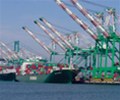

The Port of Los Angeles is beginning the hard work of convincing terminal operators, importers, warehouses owners and trucking firms to embrace moving more cargo at night.
“It’s not a single lever we can pull today to open up all the gates,” Executive Director Gene Seroka said on Thursday.
On Wednesday, the White House gathered stakeholders including retailers Walmart (NYSE:WMT) and Home Depot (NYSE:HD), logistics firms United Parcel Service (NYSE:UPS) and FedEx (NYSE:FDX), and electronics supplier Samsung (KS:005930). The companies pledged to use more overnight workers to ease the backups at the Los Angeles and Long Beach port complex that is the No. 1 gateway for trade with China.
We’re “trying to squeeze every minute, every hour of efficiency out of this port that we can,” said Seroka. Most work is currently done during the day, although some parts of the operation already run 24/7. The White House said adding more overnight shifts could double available time to move cargo and union leaders are onboard.
COVID-19 fueled demand for consumer goods while at the same time closing factories and ports. A shortfall of workers ranging from truckers to warehouse staff are driving up the cost of goods, contributing to product shortages, and raising alarms about a worsening global supply-chain crisis.
The global supply chain “was creaking along before the pandemic,” said John Porcari, port envoy for the White House Supply Chain Disruptions Task Force.
The health crisis laid bare weaknesses in a brittle global supply chain built for predictable, just-in-time cargo flows, he said. In many cases, it is “your grandfather’s infrastructure that we’re working with.”
STRESS AT EVERY LINK
The ports of Los Angeles and Long Beach significantly lag Chinese rivals when it comes to port efficiency, according to a ranking prepared by the World Bank and IHS Markit.
Port terminals in China usually operate 24/7, many tasks are automated and labor slowdowns are rare, U.S.-based shipping industry consultant Jon Monroe said.
Seroka and Porcari stressed that U.S. supply chain improvements will not come at the flip of a switch. Changes are needed at every link to ease the impact of unintended consequences, they said.
The White House efforts announced Wednesday are expected to account for just 3,500 additional containers per week being moved at night – a tiny fraction of the 120,000 containers already moving each week.
Meanwhile, there are 62 container ships waiting to unload some 500,000 containers at Los Angeles/Long Beach – and another 25 are scheduled to arrive in the next three days.
Those vessels are carrying parts and components for U.S. manufacturers as well as seasonal goods for retailers racing stock up for the Nov. 26 kickoff of the make-or-break holiday selling season, Seroka said.
Extended hours at Los Angeles/Long Beach could benefit Honda Motor Co, hit hard by the automotive chip shortage, and Mattel (NASDAQ:MAT), which is under pressure to get holiday toys to stores, according to Panjiva, the supply chain research unit of S&P Global (NYSE:SPGI) Market Intelligence.
And the effort raises the question of where to put all the stuff.
The Greater Los Angeles area logged a record low vacancy rate of 1% for warehouses and other industrial space during the third quarter, according to CBRE Group (NYSE:CBRE), a commercial real estate services firm.
“If we increase the capacity at the port, then we still have to find space to temporarily store goods in warehouses,” said Douglas Kent, an executive vice president at the Association for Supply Chain Management.
Source: Reuters (Reporting by Lisa Baertlein)